How Fast Do Snake Plants Grow?
Snake plants typically grow slowly, producing 2-4 new leaves and 1-3 new shoots each year under ideal conditions. Their growth speed depends on factors like light, water, soil, and temperature.
Snake plants, known scientifically as Dracaena trifasciata, are one of the most recognizable and popular houseplants you can find. With their striking, upright leaves that resemble swords, they bring a touch of modern elegance and architectural structure to any indoor space. But beyond their good looks, a big part of their appeal is their reputation for being almost indestructible. This resilience makes them a top choice for both beginner plant enthusiasts and seasoned gardeners looking for a low-maintenance addition to their collection.
A common question that arises for new and experienced owners alike is, “How fast do snake plants grow?” Many people label them as slow growers, and while that can be true, it’s not the whole story. The growth rate of a snake plant is not set in stone; it’s a dynamic process influenced by a range of environmental factors. Understanding these factors is the key to unlocking your plant’s full growth potential.
This comprehensive guide will explore everything you need to know about snake plant growth. We’ll dive into the specific conditions that dictate their speed of development, from light and water to the pot they call home. We will cover the average growth rate you can expect, provide actionable snake plant care tips to encourage faster growth, and troubleshoot common issues that might be stunting your plant. By the end, you’ll have a clear understanding of how to give your snake plant exactly what it needs to thrive.
What is a Snake Plant?
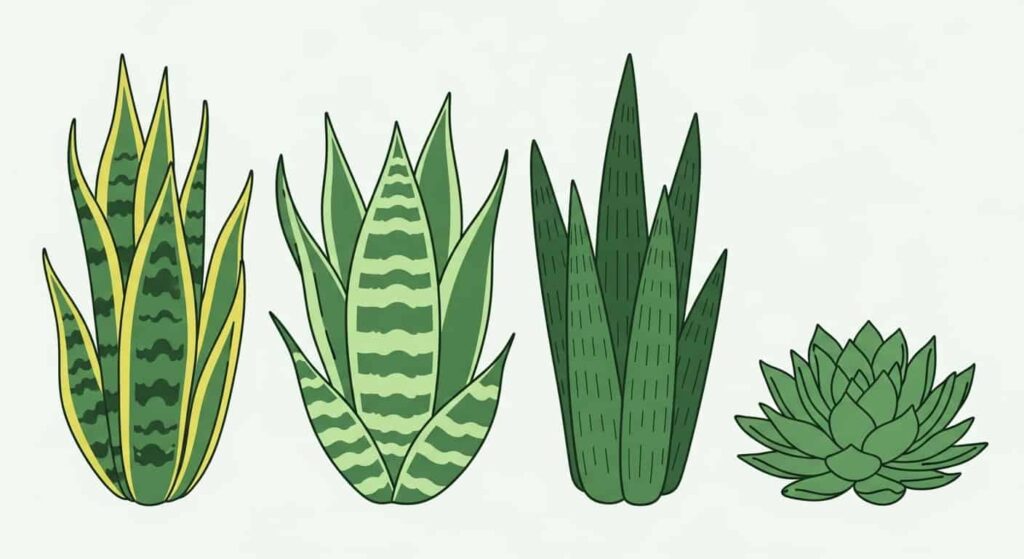
Before we dive into their growth habits, let’s get properly acquainted with these fascinating plants. Snake plants are native to tropical West Africa, from Nigeria east to the Congo. This origin gives us important clues about their preferred living conditions—they are accustomed to warm climates and can handle periods of drought.
They are also known by several other names, including mother-in-law’s tongue (a playful nod to the sharp, pointed tips of the leaves), Saint George’s sword, and viper’s bowstring hemp. The latter name comes from the fact that the strong plant fibers were historically used to make bowstrings.
There are over 70 different varieties of snake plants, each with unique characteristics. Some popular types include:
- Dracaena trifasciata ‘Laurentii’: This is perhaps the most classic variety, featuring tall, dark green leaves edged with a vibrant yellow-gold stripe.
- Dracaena trifasciata ‘Zeylanica’: Similar in form to ‘Laurentii’ but with leaves that have horizontal, wavy bands of silver or light green.
- Dracaena angolensis (formerly Sansevieria cylindrica): This variety has round, spear-like leaves that grow outwards from a central crown, creating a spiky, modern look.
- Dracaena trifasciata ‘Hahnii’ (Bird’s Nest): A dwarf variety that grows in a short, tight rosette, resembling a bird’s nest. Its compact size makes it perfect for desks and shelves.
One of the most celebrated benefits of snake plants is their air-purifying ability. They are excellent at filtering indoor air, removing toxins such as formaldehyde, xylene, toluene, and nitrogen oxides. What makes them particularly special is that they perform this process, known as Crassulacean Acid Metabolism (CAM), primarily at night. This means they release oxygen while you sleep, making them an ideal plant for bedrooms.
Factors That Influence Snake Plant Growth Rate
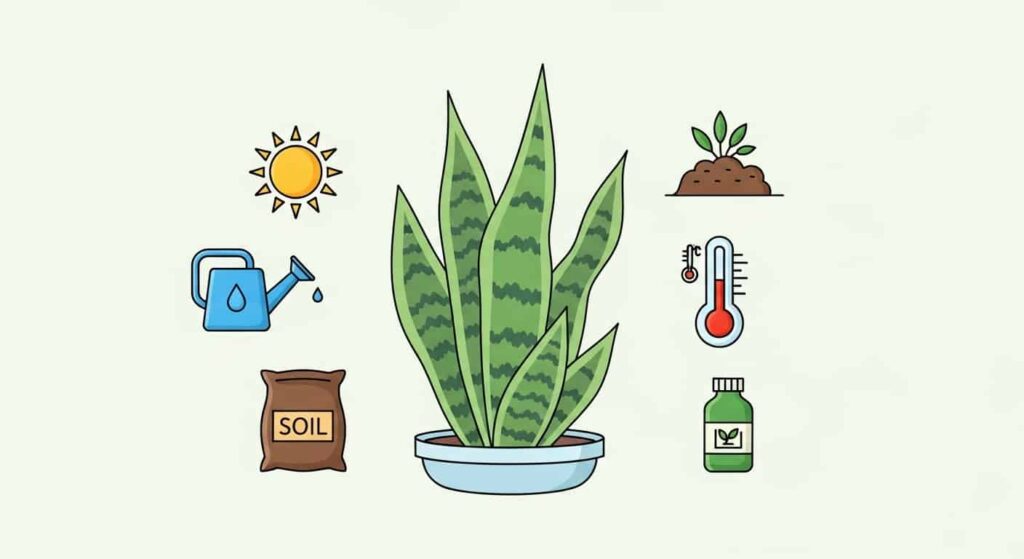
A snake plant’s growth is a direct response to its environment. While they are famously tolerant of neglect, providing them with conditions closer to their native habitat will result in a healthier, more vigorous plant. Think of it as the difference between surviving and thriving. Let’s break down the six key factors that determine how fast your snake plant will grow.
1. Light: The Most Important Growth Driver

Light is the single most critical factor influencing the snake plant’s growth rate. These plants have a reputation for being low-light tolerant, and it’s true they can survive in shady corners where other plants would wither. However, surviving is not the same as growing.
In a low-light environment, a snake plant will essentially enter a state of dormancy. It will maintain its current state, perhaps for months or even years, but you will see very little to no new growth. The plant is conserving energy, just trying to hang on.
To encourage active growth, snake plants need bright, indirect light.
- Optimal Light: An ideal spot is a few feet away from an east-facing window, where it can receive gentle morning sun. A spot near a north-facing window also works well. A location across the room from a south or west-facing window can provide the bright, ambient light they love without the risk of scorching.
- Low Light vs. Bright Light: A snake plant in a bright, indirect light setting can produce new leaves and pups multiple times a year. In contrast, one kept in a dark hallway might not produce a single new leaf in a year. The difference is stark.
- Direct Sunlight: While they appreciate brightness, intense, direct afternoon sun can be too much. It can scorch the leaves, causing them to turn yellow, develop brown, crispy spots, or become washed out in color. A little direct morning sun is generally fine, but avoid harsh midday rays.
If you notice your snake plant’s leaves are leaning or stretching towards a window (a phenomenon called etiolation), it’s a clear sign it’s desperate for more light.
2. Water: The Fine Art of Less is More
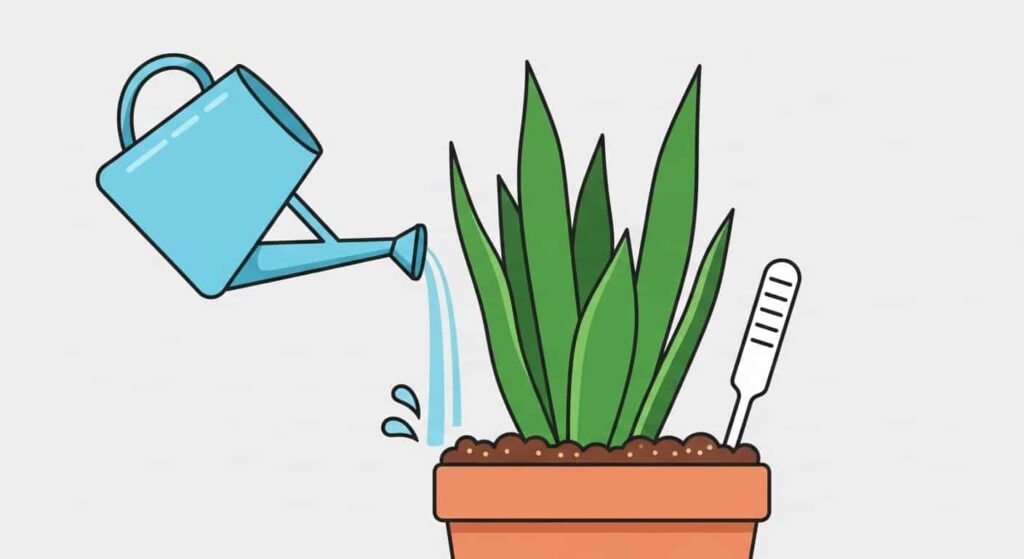
Overwatering is the number one killer of snake plants. Their succulent-like leaves and rhizomatous root system are designed to store water, making them highly susceptible to root rot if left in soggy soil. This is the most common reason for stunted growth or a plant’s untimely demise.
- Watering Frequency: The golden rule for snake plants is to let the soil dry out completely between waterings. Don’t water on a fixed schedule. Instead, check the soil. The best method is to stick your finger two to three inches deep into the soil. If it feels even slightly damp, wait longer.
- Seasonal Adjustments: During the spring and summer growing season, you might need to water every 2-4 weeks, depending on the light, temperature, and humidity in your home. In the fall and winter, when the plant’s growth naturally slows, you should reduce watering dramatically, perhaps to once every 6-8 weeks or even less.
- Proper Watering Technique: When you do water, do it thoroughly. Pour water over the soil surface until it begins to drain freely from the bottom of the pot. This ensures the entire root system gets a drink. After a few minutes, discard any excess water that has collected in the saucer. Never let the plant sit in a tray of standing water.
Underwatering is far less of a risk. The plant will show you it’s thirsty. The leaves might start to look slightly wrinkled or may curl inward. Once you water it, it will typically perk back up within a day or two. Remember, a thirsty snake plant is fixable; a rotten one is often not.
3. Soil and Potting: The Foundation for Healthy Roots
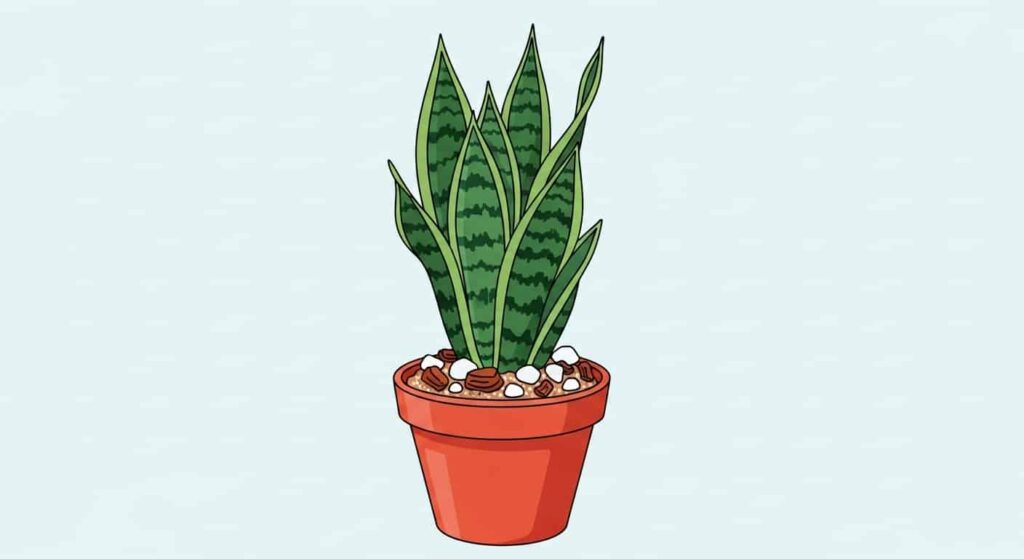
The right soil and pot combination is crucial for preventing waterlogging and providing a stable base for your plant. Snake plants need a potting mix that drains exceptionally well.
- The Best Soil Mix: Standard potting soil is often too dense and retains too much moisture. A better choice is a specialty cactus or succulent mix, which is formulated for sharp drainage. You can also create your own ideal mix by combining one part standard potting soil with one part perlite (or pumice) and one part coarse sand or orchid bark. This creates a chunky, airy medium that allows roots to breathe and water to pass through quickly.
- Pot Selection: The pot you choose is just as important as the soil. Ensure your pot has at least one drainage hole. This is non-negotiable. Terracotta or clay pots are excellent choices because the porous material helps wick moisture away from the soil, allowing it to dry out faster. If you use a plastic or glazed ceramic pot, you must be even more diligent about checking soil moisture before watering.
- Pot Size: Snake plants grow best when they are slightly root-bound. They enjoy being snug in their pots. Potting a small snake plant into a very large pot is a common mistake. The excess soil will hold onto moisture for too long, creating a prime environment for root rot. Only repot your snake plant when it becomes severely root-bound—you might see roots growing out of the drainage holes, or the plant may even crack its plastic pot. When you do repot, choose a new pot that is only 1-2 inches larger in diameter.
4. Temperature and Humidity: Mimicking Their Native Climate

As tropical plants, snake plants prefer warm conditions and are not frost-tolerant. Keeping them within their ideal temperature range will support consistent growth.
- Ideal Temperature: Snake plants thrive in temperatures between 70°F and 90°F (21°C and 32°C). They are quite tolerant of average household temperatures, but growth will slow significantly if the temperature drops below 60°F (15°C).
- Cold Sensitivity: They are very sensitive to cold drafts and frost. Keep them away from drafty windows or doors, especially in winter. A sudden cold snap can damage the leaves, causing mushy spots to form. Never leave them outside if temperatures are predicted to drop below 50°F (10°C).
- Humidity: Snake plants are not fussy about humidity. Their native environment can be humid, but they have adapted to be highly tolerant of the dry air found in most modern homes. Average household humidity is perfectly fine. There is no need for a humidifier or misting, which can sometimes do more harm than good by encouraging fungal issues on the leaves if airflow is poor.
5. Fertilizer: A Modest Boost for Growth
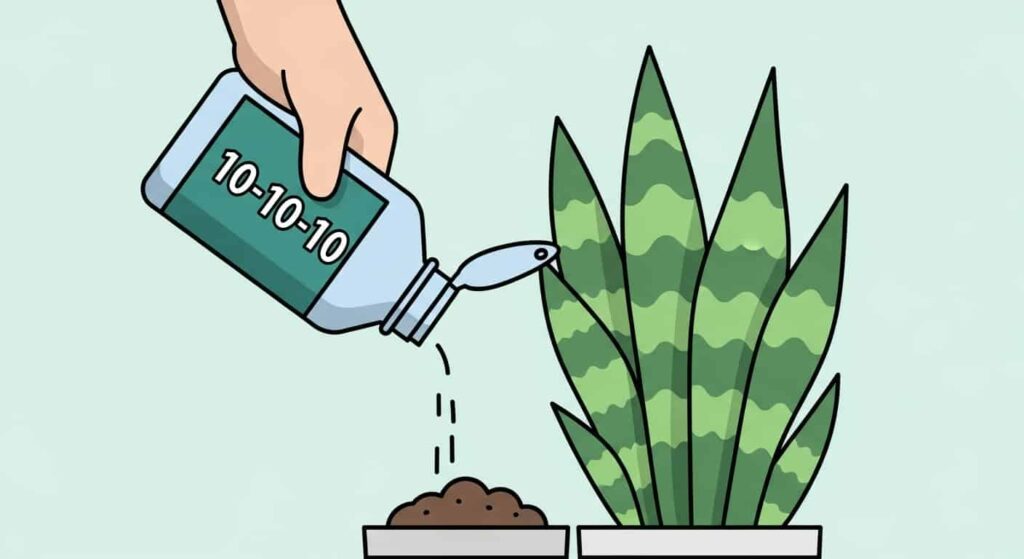
Snake plants are not heavy feeders. They can get by for a long time with just the nutrients present in their soil. However, providing a little bit of fertilizer during their active growing season can give them the boost they need for faster growth and more vibrant foliage.
- When to Fertilize: Only fertilize during the spring and summer months. This is when the plant is actively putting out new growth and can make use of the extra nutrients. Do not fertilize in the fall or winter, as the plant is resting and the unused fertilizer salts can build up in the soil and burn the roots.
- What Fertilizer to Use: A balanced, all-purpose liquid houseplant fertilizer is a good choice. Look for one with a balanced N-P-K ratio like 10-10-10 or 20-20-20. Alternatively, you can use a fertilizer formulated specifically for cacti and succulents.
- How to Apply: Dilution is key. To be safe, dilute the fertilizer to half the strength recommended on the package instructions. Apply the diluted fertilizer to the soil once a month during the growing season. It’s best to apply it after you’ve already watered the plant to avoid burning the roots.
Over-fertilizing is a more common problem than under-fertilizing. Signs of fertilizer burn include brown, crispy leaf edges and tips. If you suspect you’ve used too much, you can flush the soil by watering the plant thoroughly and letting it drain completely several times.
Average Growth Rate of Snake Plants
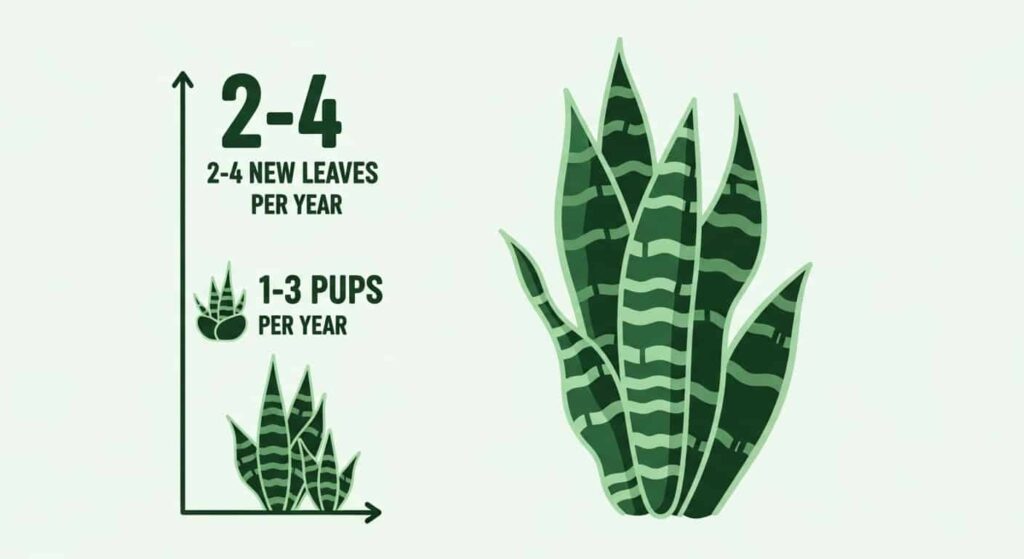
So, with all those factors in mind, how fast do snake plants actually grow? The answer depends entirely on the conditions you provide.
- Under Optimal Conditions: When a snake plant is given bright, indirect light, appropriate water, and warm temperatures, it is a moderately fast grower. In a single growing season (spring and summer), you can expect to see 3 to 5 new leaves emerge from the center of each rosette. Additionally, a healthy, mature plant will send out underground rhizomes, which will sprout into new baby plants, known as “pups,” around the base of the mother plant. You could see 1 to 3 new pups in a year.
- Under Sub-Optimal (but Surviving) Conditions: This is the scenario for most snake plants. In a medium to low-light setting with infrequent watering, growth will be much slower. You might only see 1 new leaf per year, or even none at all. The plant will look healthy, but it won’t be actively growing. Pups will be a rare occurrence.
The type of snake plant also plays a role. Tall, upright varieties like ‘Laurentii’ or ‘Zeylanica’ tend to focus their energy on vertical growth, so you’ll notice new leaves emerging from the center and growing taller. Dwarf varieties like the ‘Hahnii’ bird’s nest snake plant will produce new leaves from the center, but also spread horizontally by producing pups more readily, forming a dense cluster. Cylindrical snake plants grow new spears from the base.
How to Encourage Faster Snake Plant Growth

If your snake plant seems stuck in time and you want to give it a nudge, you can take several steps to optimize its environment. Following these snake plant care tips will significantly improve its growth rate.
- Move It to a Brighter Location: This is the most impactful change you can make. If your plant is in a dim corner, gradually acclimate it to a spot with bright, indirect light. An east-facing window is perfect. The increased light energy will fuel photosynthesis and trigger new growth, often within a few weeks.
- Establish a Proper Watering Routine: Ditch the schedule and learn to read your plant and its soil. Water deeply but infrequently. Let the soil dry completely. This prevents root rot, the silent killer that halts all growth. Using a pot with excellent drainage is essential.
- Repot if Necessary (But Don’t Rush It): Check if your plant is severely root-bound. If roots are circling the bottom of the pot or pushing the plant up out of the soil, it’s time for a new home. Choose a pot just 1-2 inches wider. Repotting into fresh, well-draining soil will provide new nutrients and space for the roots to expand, stimulating a growth spurt. The best time to repot is in the spring.
- Fertilize During the Growing Season: A light feeding can make a big difference. Use a half-strength balanced fertilizer once a month from spring through summer. This provides the micronutrients needed for producing new leaves and pups.
- Keep It Clean: Dust can accumulate on the broad leaves of a snake plant, blocking light and hindering photosynthesis. Gently wipe the leaves down with a damp cloth every few months. This not only helps the plant breathe and absorb light but also keeps it looking its best.
- Provide Stable, Warm Temperatures: Keep your plant in a spot where the temperature is consistently above 65°F (18°C) and away from cold drafts from windows, doors, or AC vents. Stable warmth encourages steady growth.
By implementing these strategies, you are creating an environment where your snake plant doesn’t just have to survive; it can truly flourish.
Common Issues That Slow Down Growth
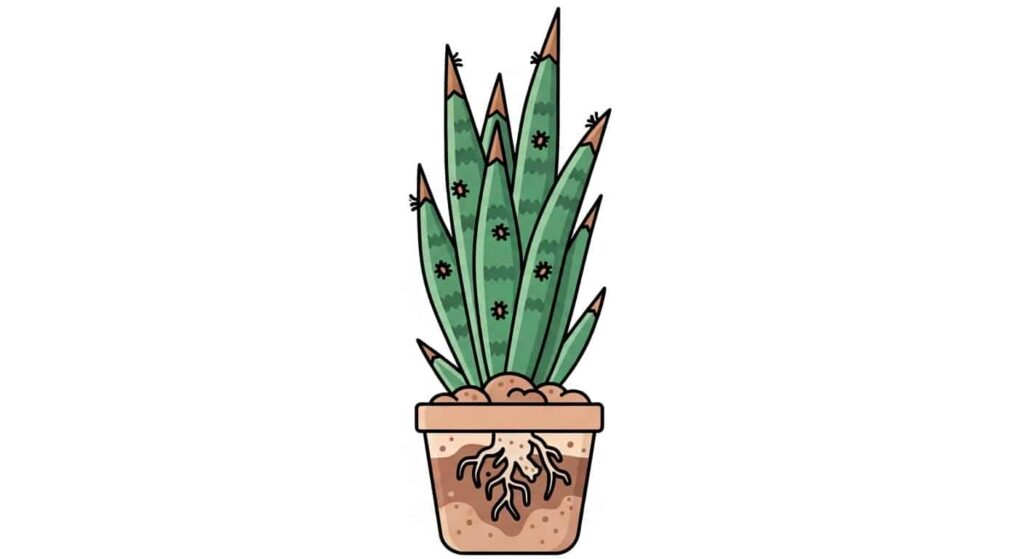
If you’ve tried the tips above and your plant is still not growing, it might be suffering from a specific problem. Here are some common issues that can stunt a snake plant’s growth and how to identify and fix them.
Root Rot
As mentioned, this is the most frequent culprit. It’s caused by overwatering or poor drainage.
- Symptoms: Slow or no growth, yellowing leaves (especially at the base), a soft or mushy base, and a foul odor coming from the soil. If you gently tug on the plant, it may feel loose in the pot.
- Solution: You must act quickly. Remove the plant from its pot and inspect the roots. Healthy roots are firm and white or light tan. Rotted roots will be brown/black, mushy, and may fall apart when touched. Using a sterile knife or shears, cut away all rotted portions. If there are healthy roots left, you can repot the plant in fresh, dry, well-draining soil. Do not water it for at least a week to allow the cut roots to heal. If all the roots are rotted, you may still be able to save the plant by taking healthy leaf cuttings to propagate.
Pest Infestations
While snake plants are quite pest-resistant, they can occasionally fall prey to common houseplant pests, which feed on the plant and sap its energy, halting growth.
- Common Pests: Mealybugs (look for small, white, cottony masses in the crevices of the leaves), spider mites (look for fine webbing and tiny specks on the undersides of leaves), and scale (look for small, brown, immobile bumps).
- Solution: Isolate the infested plant to prevent pests from spreading. For a light infestation, you can dip a cotton swab in rubbing alcohol and manually remove the pests. For a larger problem, spray the entire plant with an insecticidal soap or neem oil solution, making sure to coat the undersides of the leaves. You may need to repeat the treatment every 7-10 days for a few weeks to eliminate all life stages of the pests.
Incorrect Pot Size
A pot that is too large can be just as problematic as one that is too small.
- Symptoms of a Too-Large Pot: The plant’s growth seems stalled after repotting. The soil stays wet for a very long time. This is because the plant’s roots are unable to absorb the water from the large volume of soil, leading to a high risk of root rot.
- Solution: Repot the plant into a smaller, more appropriately sized pot that is just slightly larger than the root ball. This will help the soil dry out more quickly and encourage the plant to focus its energy on new leaf growth rather than trying to fill a vast pot with roots.
Insufficient Nutrients
While they don’t need much, a plant that has been in the same soil for many years may have exhausted all the available nutrients.
- Symptoms: Slow growth, pale or washed-out leaf color.
- Solution: If it’s been several years since you last repotted, refreshing the soil can provide a new supply of nutrients. Alternatively, start a gentle fertilizing routine during the growing season as described above.
Conclusion: Patience and Observation are Key

The snake plant has rightfully earned its place as a staple of indoor gardening. Its architectural beauty and incredible resilience make it a forgiving and rewarding plant for any home. When it comes to the snake plant growth rate, the power is largely in your hands. While they are known as slow growers, this is often a reflection of sub-optimal, low-light conditions.
By providing your plant with the key elements it craves—bright indirect light, infrequent but thorough watering, well-draining soil, and occasional feeding—you can transform it from a static decoration into a dynamic, growing part of your home. You’ll be rewarded with taller, more vibrant leaves and the exciting emergence of new pups that you can either leave to create a fuller plant or propagate to share with others.
Pay attention to your plant. Its leaves, soil, and overall posture will tell you what it needs. A little observation and a commitment to providing the right care will ensure your snake plant not only survives but thrives for many years to come, proving that this “slow” grower has a surprising amount of vigor just waiting to be unlocked.

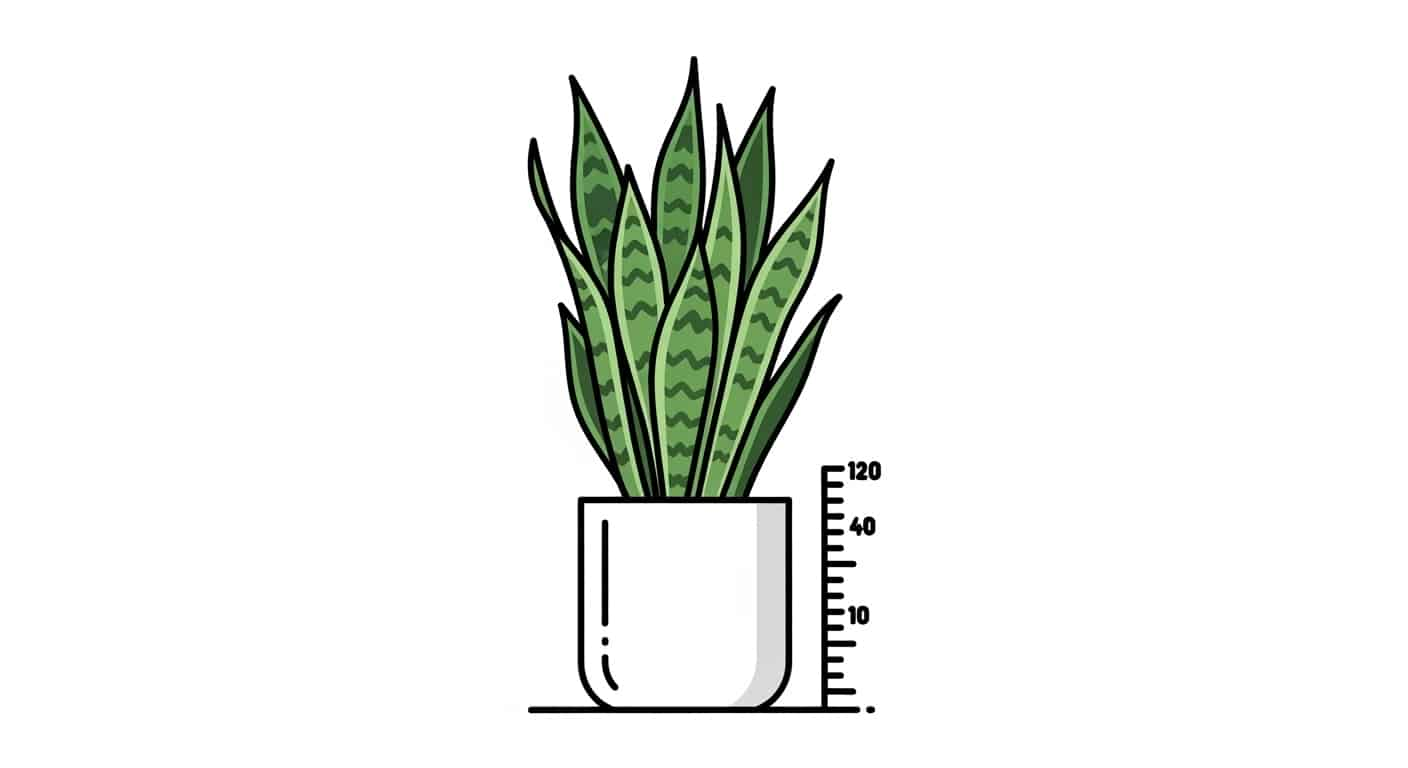
Leave a Reply to Do Snake Plants Like Humidity? 7 Proven Tips to Keep Them Thriving (Essential Guide) – Indoor Plant Nook Cancel reply